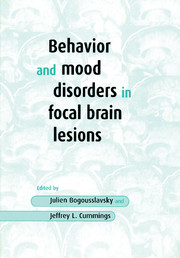Book contents
- Frontmatter
- Dedication
- Contents
- List of contributors
- Preface
- Acknowledgments
- 1 Emotional consequences of focal brain lesions: an overview
- 2 The evaluation of mood and behavior in patients with focal brain lesions
- 3 Methodological issues in studying secondary mood disorders
- 4 Emotional behavior in acute brain lesions
- 5 Depression and lesion location in stroke
- 6 Mood and behavior in disorders of the basal ganglia
- 7 Mania and manic-like disorders
- 8 Behavioral and emotional changes after focal frontal lobe damage
- 9 Disorders of motivation
- 10 Thalamic behavioral syndromes
- 11 Obsessive-compulsive disorders in association with focal brain lesions
- 12 Emotional dysprosody and similar dysfunctions
- 13 Temporal lobe behavioral syndromes
- 14 Neural correlates of violent behavior
- 15 Focal lesions and psychosis
- 16 Alterations in sexual behavior following focal brain injury
- 17 Anosognosia
- 18 Acute confusional states and delirium
- Index
9 - Disorders of motivation
Published online by Cambridge University Press: 05 August 2016
- Frontmatter
- Dedication
- Contents
- List of contributors
- Preface
- Acknowledgments
- 1 Emotional consequences of focal brain lesions: an overview
- 2 The evaluation of mood and behavior in patients with focal brain lesions
- 3 Methodological issues in studying secondary mood disorders
- 4 Emotional behavior in acute brain lesions
- 5 Depression and lesion location in stroke
- 6 Mood and behavior in disorders of the basal ganglia
- 7 Mania and manic-like disorders
- 8 Behavioral and emotional changes after focal frontal lobe damage
- 9 Disorders of motivation
- 10 Thalamic behavioral syndromes
- 11 Obsessive-compulsive disorders in association with focal brain lesions
- 12 Emotional dysprosody and similar dysfunctions
- 13 Temporal lobe behavioral syndromes
- 14 Neural correlates of violent behavior
- 15 Focal lesions and psychosis
- 16 Alterations in sexual behavior following focal brain injury
- 17 Anosognosia
- 18 Acute confusional states and delirium
- Index
Summary
Introduction
During the last 20 years or so, several reports (mainly in the French-speaking neurological literature) have dealt with the description of profound behavioral and personality changes occurring abruptly following small focal brain lesions in the basal ganglia regions, and presenting as isolated disturbances in motivation and action.
Such disturbances have been variously named ‘loss of psychic self-activation,' 'pure psychic akinesia,’ or ‘athymhormic syndrome.’ At present, about 20 such cases of specific motivational disorders due to focal subcortical lesions have been reported in some detail (Table 9.1). In all of these cases, the authors have emphasized the fact that these disorders of personality and affect arose in subjects without any previous psychiatric disorder, and entailed dramatic behavioral changes, disproportionate to cognitive involvement, which remained, if at all, quite moderate. Beyond their clinical interest, these observations have also contributed toward deepening our knowledge of the role of subcortical brain structures in a previously almost unexplored area of brain/mind relationships.
The purposes of this chapter are: (1) to summarize the clinical features of these observations and to show that, collectively, these features may comprise a distinct neurobehavioral syndrome; (2) to provide arguments suggesting that this syndrome results from the disruption of a specific brain system and to delineate, on the basis of radio-anatomical/behavioral correlations, the structural organization of this brain system; and (3) to propose a tentative neuroanatomical and psychodynamic model of human motivation.
Clinical descriptions of isolated motivational disorders following focal brain damage
Overview of clinical concepts and terminology
This chapter deals with a group of behavioral disorders that have been variably termed in the early neurological literature as ‘placidity’ or ‘abulia,’ and that were often considered as a milder form of akinetic mutism. This position, which was dominant in classical neurological writings, has probably obscured the real nature of these disorders and of their anatomical substrate, the only suggested pathophysiology being an interruption of fronto-thalamic connections. One interesting approach, however, has been the endeavor of some psychiatrists to group under the term ‘apathy’ certain behavioral traits shared by both psychiatric and neurological patients. Marin (1990) thus defined apathy as ‘absence or lack of feeling, emotions, interest, or concern,’ and proposed that it ‘refers primarily to lack of motivation,’ clearly suggesting that human motivation, as one aspect of the emotional life, may be the object of clinical investigation.
- Type
- Chapter
- Information
- Behavior and Mood Disorders in Focal Brain Lesions , pp. 261 - 284Publisher: Cambridge University PressPrint publication year: 2000
- 5
- Cited by



